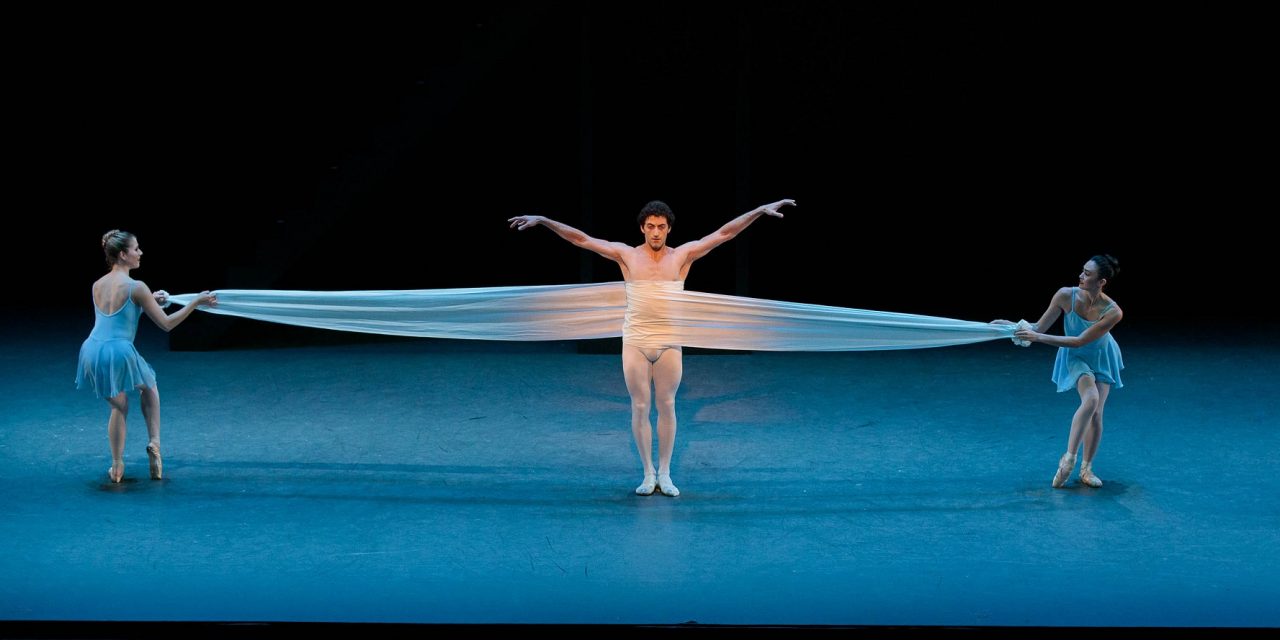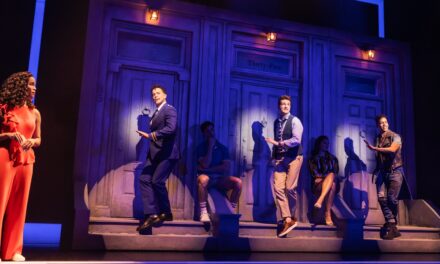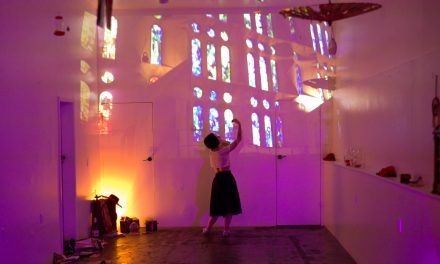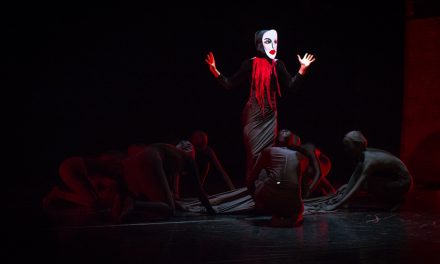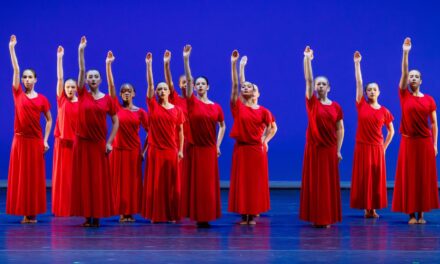On February 27, 2020, The Broad Stage presented Los Angeles Ballet’s, “Balanchine Black and White” The evening’s offering of three Balanchine’s early masterpieces, Agon, Apollo and Concerto Barocco was a welcome remembrance. The re-staging was done by Colleen Neary, one of Balanchine’s handpicked elite Répétiteurs, handed down by “Mr. B” and the Balanchine Trust.
Ms. Neary, along with Thordal Christensen, are Co-Artistic Directors of the Los Angeles Ballet. In her informative pre-show presentation, she shared that she was one of the last generations (1969-1979) of dancers to work with Balanchine at the New York City Ballet. Now she is among 30 elite artists who re-stage his work around the world as well as making it possible to present his work here in Los Angeles.
Her reflections of Balanchine, his musicality and creative choreographic genius, requires not only technique, strength, and energy but the musicality of a schooled musician. Because of his background in music, he surrounded himself with brilliant and forward-thinking friends (among others, Stravinsky and Hindemith) that fed his love of music and story. As Neary mused, she was not a schooled musician, but he encouraged her to study the scores of ballets, thus making 12-tone pieces intelligible. This prepared her for her future to take on the Balanchine legacy. His generosity was an inspiration to many young and upcoming dancers, choreographers and companies. He loved life, food, women and men – He loved Los Angeles. His life was an immigrant story and, as a new American, he gave so much to dance in America.
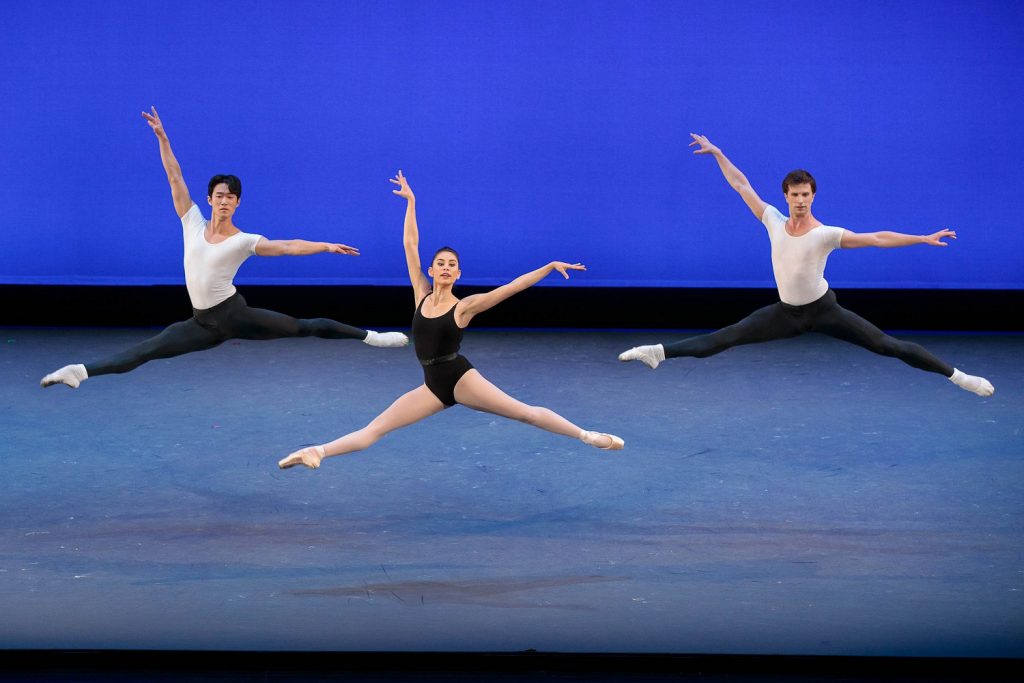
Los Angeles Ballet – Balanchine Black and White – Julianne Kinasiewicz with Jeongkon Kim and Magnus Christoffersen in AGON – Photo by Reed Hutchinson
In Agon, the first on the program, which previewed in 1957 Igor Stravinsky was the composer and Robert Craft, the conductor along with the dazzling Diana Adams and Arthur Mitchell and the corps of NYCB. The idea of dancers using rehearsal clothes instead of formal costuming started taking shape at around this time. Thus, the title of the presentation, “Balanchine Black and White”. Seeing the dancers in tights and leotards introduced the audience to the full aesthetics brilliance of the dancer’s body and movements. Balanchine, even though not popular at this time, loved Mitchell’s and Adams’ differing skin tones when they danced together. Mitchell being Black and Adams, White. His fierce independence made not only an aesthetic statement, but a social one.
Agon was fashioned after the Court Dances of the 17th Century – Czardas, Bourrée, even a sultry flamenco-like solo, replete with snapping whip sounds. The pas de trois with Julianne Kinasiewicz, Jeongkon Kim and Clay Murray was nicely executed with a melding of fire and legato transitions. The famed “Adams and Mitchell” pas de deux was performed by Petra Conti and Eris Nezha, moving beautifully through its body-twisting spirals and poses. Fascinating to watch, the audience was carried along in the immediacy of the movement. The musical pacing, the stop and go formality of the bowing and posing, the explosion of energy and the seductive technically difficult execution were reminders of the creative genius of “Mr. B” and the need for real proficiency in doing his work.
In this opening of the piece, the four men, Eris Nezha, Tigran were particularly strong and were joined by Jeongkon kim and Clay Murray, who appeared less seasoned, but committed. The eight women led by Petra Conti and Julianne Kinasiewicz, aptly drove the corps through Stravinsky’s difficult timings and passages along with Balanchine’s ever rapidly moving footwork. In this quite capable group, only one or two female corps members appeared to be dancing to their own musical and technical tune, incapable of finding their sea legs in this demanding piece. Perhaps an otherwise correctable defect.
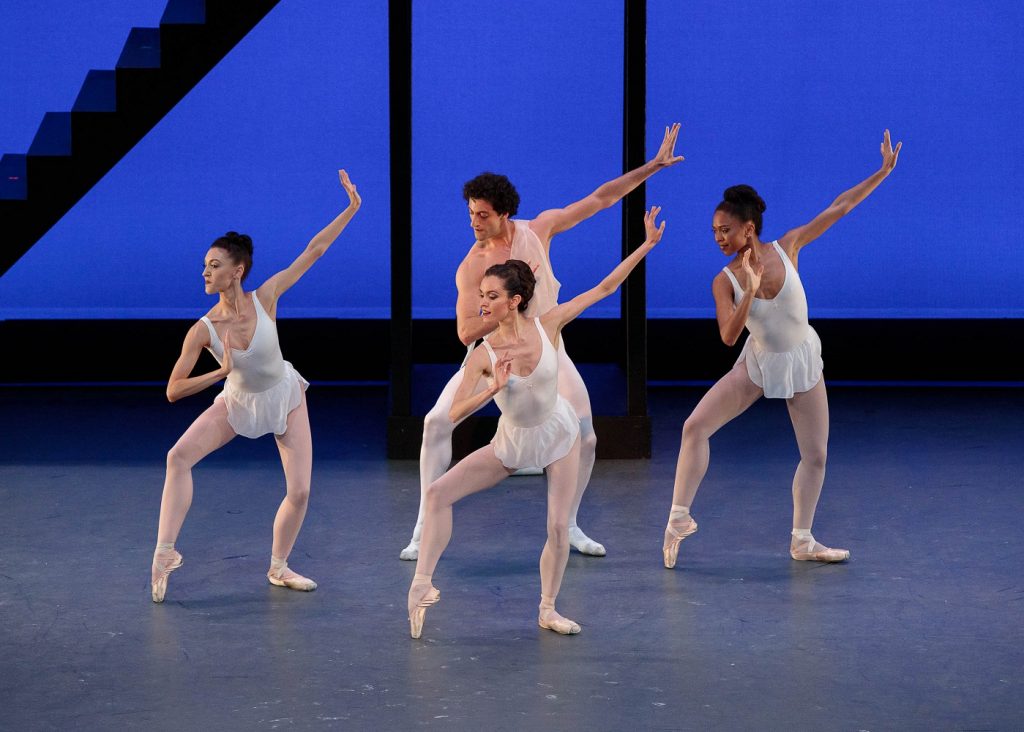
Los Angeles Ballet – Balanchine Black and White – Petra Conti, Jasmine Perry, Laura Chachich, with Tigran Sargsyan in APPOLLO – Photo by Los Angeles Ballet – Blanchine Black and White – AGON – Julianne Kinasiewicz with Jeongkon Kim and Magnus Christoffersen – Photo by Reed Hutchinson
Balanchine’s Apollo, choreographed in 1928 when he was just 24 years old, was his first collaboration with Igor Stravinsky and was done for Diaghilev and the Ballet Russes. He fashioned the piece from his love and exposure to classic art. According to Neary, the inventive movements were often created and patterned after his own life experiences, and often done early in the morning while ironing his clothes for the day. An example was the pulsating outstretched hands of Apollo, opening then closing, like the neon lights of New York City.
Apollo was shaped from the story of the Greek mythical god of music. A neoclassic ballet in two tableaux. Stravinsky was inspired to fashion his music after Lully’s 17th century musical style of the French Overture. In the opening, the curtain reveal the depiction of Apollo’s mother, Leto (Leah McCall) in the throes of an agonizing birth (quite controversial for the 1930’s). With hair thrashing and body convulsing, she finally births her son Apollo atop a mountain on the island of Delos, represented by a one-story stairway with a platform at its peak.
The god, Apollo is danced by Tigran Sargasyan, with his depiction of the beautiful, the masculine and irresistible Apollo. We first see his body being unwrapped from his cocoon by three muses; Calliope, Laura Chachich playing the spirited muse of poetry; Polyhymnia, the lovely Jasmine Perry cast as the muse of mime; and Terpsichore, muse of dance, beautifully performed by Petra Conti. Her lyrical and captivating styling, used the space to move in playful abandon, reaching, then withdrawing, and finally joining Apollo in the acclaimed pas de deux. Finally, with all three muses coming together and joining Apollo in forming the iconic tableau of arabesques in a layered peacock-like fan formation to end the piece.
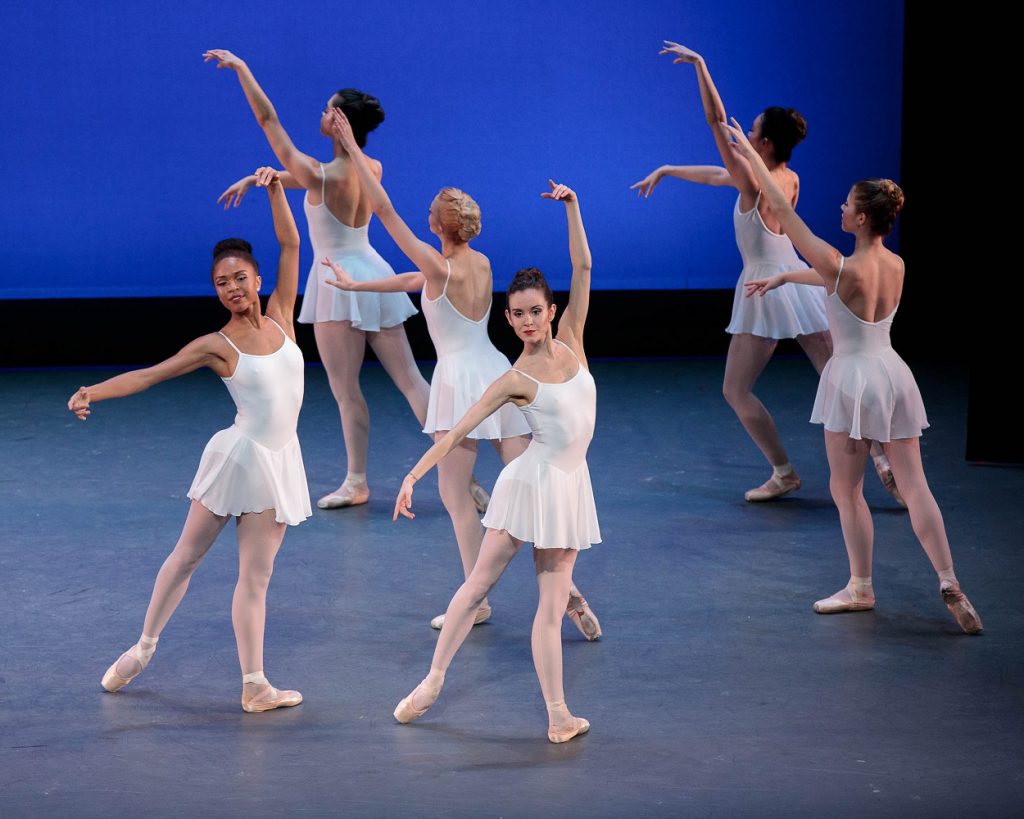
Los Angeles Ballet – Balanchine Black and White – Petra Conti, Jasmine Perry and LAB Ensemble in CONCERTO BAROCCO – Photo by Reed Hutchinson
The last, and quite formidable Concerto Barocco ended the program. The brilliant music of Johann Sebastian Bach’s Concerto in D Minor for Double Violins was a musical, to say nothing of a dance, masterpiece. “Barocco” made its debut on June 27, 1941 at Teatro Municipal in Rio de Janeiro, as part of American Ballet Caravan’s South American tour.
In this L.A. production, the First Violin was performed by Petra Conti, while Second Violin was Laura Chachich. Both proved their strength and capable leadership. The corps, Balanchine explained was the “orchestra” surrounding the solo violins. The corps never leaves the stage, nor rests, in this challenging piece.
According to Neary, originally the piece was an all-female cast, but as the story goes, a young male dancer entered the rehearsal hall during the second movement by accident and Balanchine choreographed him into the piece and there he stays until the present. The difficulty of “Barocco” is it truly separates the professionals from the un-initiated because of the required musicality, the intense focus and the remarkable technical facility required not only of the soloists but the corps in executing this masterpiece with proficiency and abandon.
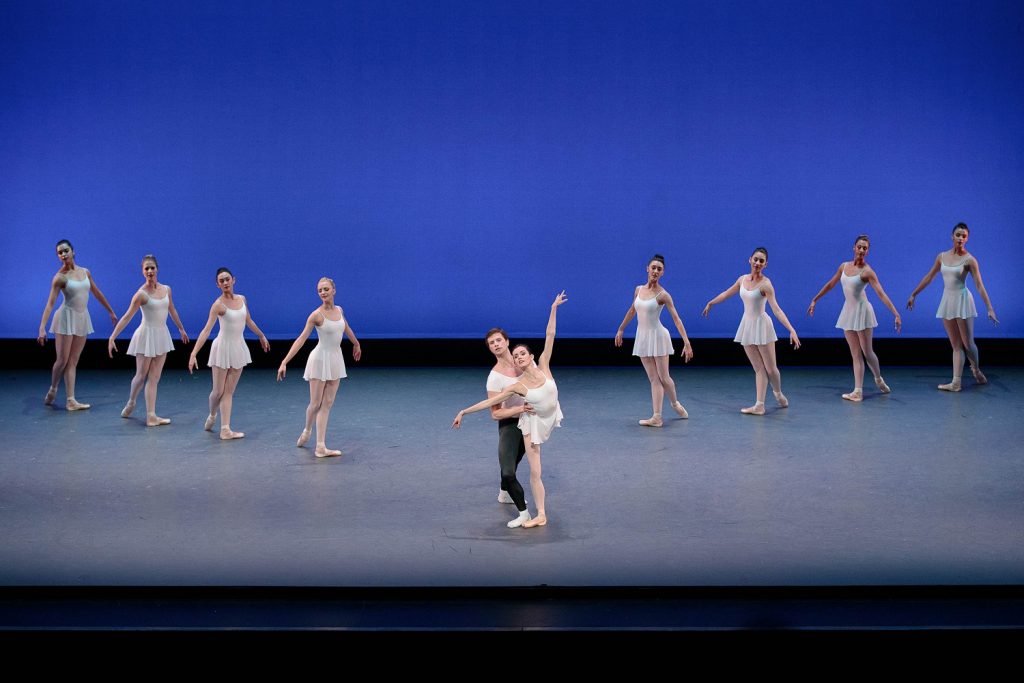
Los Angeles Ballet – Balanchine Black and White – Petra Conti, Magnus Christoffersen and LAB Ensemble in CONCERTO BAROCCO – Photo by Reed Hutchinson
The L.A. Ballet Dancers did a favorable job of bringing Balanchine to L.A. audiences. However, what seemed to be missing in a few dancers, was the presence of Balanchine’s standards: being the music, letting the movement project the spirit and dance moment-to-moment without force or “selling”, no matter how difficult. He always said to let the dance tell the story with no extemporaneous facial commentary. Ms. Neary, without a doubt, strove to enliven her conscripted group in this way, and succeeded for most part. The calm feminine Mona Lisa demeanor rose quite beautifully from most, others did not or could not succeed.
Perhaps the devotion to the real personage of Balanchine encouraged the spirit of this great artist which seemed to create an edge to the iconic New York City Ballet. Perhaps the competition of impossibly brilliant dancers all in one amazing space created his world-class company – A very hard bar to reach. However, because New York City Ballet has been absent from L.A. for many years as this reviewer remembers, there is a missing spirit of fierce and brilliant creativity that most definitely requires upkeep and support. This makes the challenge that much more important to keep alive for posterity. Perhaps doing more of the Balanchine works, more often, will allow this ferocity to thrive, expand and grow as the legacy of ballet in L.A. is the L.A. Ballet in L.A.
Written by Joanne DiVito for LA Dance Chronicle, March 4, 2020.
To visit the Los Angeles Ballet website, click here.
Featured image: Los Angeles Ballet – Balanchine Black and White – Tigran Sargsyan with Hannah Keene and McKenzie Bryne in APPOLLO – Photo by Reed Hutchinson

